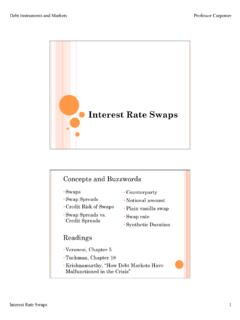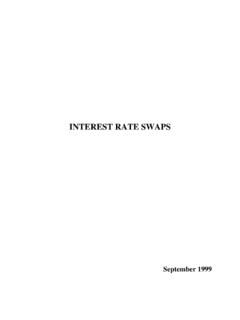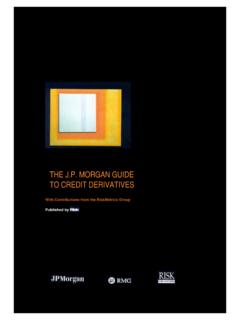Transcription of Understanding the Butterfly strategy - James Goulding
1 THE WORLD'S LOCAL BANKUNDERSTANDING THEBUTTERFLY STRATEGYRI NOTES N 2002-01L. MARTELLINI, P. PRIAULETand S. PRIAULETRESEARCH AND INNOVATION NOTES N 2002-01 Understanding THE Butterfly STRATEGYL ionel Martellini1,Philippe Priaulet2 et St phane Priaulet 3 AbstractA Butterfly , which is a combination of a barbell and a bullet, is one of the most commonactive fixed-income strategies used by practitioners. While being neutral to small parallelshifts of the yield curve, a Butterfly is purposely exposed to specific bets on particularchanges of the yield curve. There exist four different types of butterflies, the cash-and$duration neutral weighting Butterfly , the fifty-fifty weighting regression, the regressionweighting Butterfly and the maturity weighting Butterfly . In this paper, we show that theygenerate a positive pay-off when the particular flattening or steepening move of the yieldcurve they were structured for capturing occurs.
2 We also argue that one suitable way todetect the opportunity to enter a specific Butterfly is to use spread indicators. Finally, weshow that the curvature $duration obtained from the Nelson and Siegel (1987) model canbe used to measure the curvature risk of this : fixed-income portfolio management, active strategy , Butterfly , slopemovement, spread indicators, curvature re version : March 2002 Derni re version : March 2002 Version : 1 1 Lionel Martellini is currently an Assistant Professor of Finance at the Marshall School of Business,University of Southern California. Email: Philippe Priaulet is Head of Fixed Income Research in the Research and Innovation Department of HSBC-CCF. Postal Address: CCF DRI DEFE - 75419 Paris Cedex 08, France.
3 T l: (+33) 1 40 70 34 83. Fax: (+33) 1 4070 30 31. E-mail: St phane Priaulet is Head of Quantitative Engineering in the Quantitative Research and Management teamof the Structured Asset Management department at AXA Investment Managers. and Innovation Notes - N A CONVEX DIFFERENT KINDS OF CASH AND $DURATION NEUTRAL FIFTY-FIFTY REGRESSION HOW TO MEASURE THE PERFORMANCE AND THE RISK OF A Butterfly ?.. TOTAL RETURN SPREAD LEVEL, SLOPE AND CURVATURE $DURATION RISK OF RESEARCH AND INNOVATION and Innovation Notes - N 2002-01- 1 TTHHEE BBUUTTTTEERRFFLLYY SSTTRRAATTEEGGYYINTRODUCTIONA Butterfly is one of the most common fixed-income active strategies used by It is thecombination of a barbell5 (called the wings of the Butterfly ) and a bullet6 (called the body of thebutterfly).
4 The purpose of the trade is to adjust the weights of these components so that thetransaction is cash-neutral and has a $duration equal to zero. The latter property guarantees aquasi-perfect interest -rate neutrality when only small parallel shifts affect the yield curve. Besides,the Butterfly , which is usually structured so as to display a positive convexity, generates a positivegain if large parallel shifts occur. On the other hand, as we let the yield curve be affected by morecomplex movements than parallel shifts, including slope and curvature movements, theperformance of the strategy can be drastically impacted. It is in general fairly complex to knowunder which exact market conditions a given Butterfly generates positive or negative pay-offswhen all these possible movements are accounted for.
5 There actually exist many different kinds ofbutterflies (some of which are not cash-neutral), which are structured so as to generate a positivepay-off in case a particular move of the yield curve occurs. Finally, we address the question ofmeasuring the performance and the risk of a Butterfly . 4 See Choudry (2001) for a description of this strategy including in particular an example of a Butterfly analysis A barbell portfolio is constructed by concentrating investments on the short-term and the long-term ends of the A bullet portfolio is constructed by concentrating investments on a particular maturity of the yield and Innovation Notes - N 2002-01- 2 A CONVEX TRADEWhen only parallel shifts affect the yield curve, the strategy is structured so as to have a positiveconvexity.
6 The investor is then certain to enjoy a positive pay-off if the yield curve is affected by apositive or a negative parallel shift. This point is illustrated in the following 1 We consider three bonds with short, medium and long maturities whose features aresummarized in the following RateYTMBond Price$DurationQuantity2 Years5%5% Years5%5% ,00010 Years5%5% bonds are hypothetical bonds assumed to be default-risk face value of bonds is normalized to be $100, YTM stands for yield-to-maturity, bond prices are dirtyprices and we assume a flat yield-to-maturity curve in this example. We structure a Butterfly in thefollowing way:- we sell 1,000 5-year maturity bonds- we buy sq 2-year maturity bonds and lq 10-year maturity bondsThe quantities sq and lq are determined so that the Butterfly is cash and $duration neutral, , we imposethat they satisfy the following system: = + = + 100000,1)100()100( ,1) () (lslsqqqqwhose solution is = = ,100900, course, in a real market situation, we would buy 579 2-year maturity bonds and 421 10-year We now draw the profile of the strategy gain depending on the value of the yield to maturity (seeFigure 1).
7 7 On the market you actually buy bonds in terms of amount and not in terms of number of securities. You will or notround the amount you want to buy, depending on the minimum amount of the security that can be purchased. Here, forsimplicity, the quantity of bonds is measured in terms of and Innovation Notes - N 2002-01- 3 1. Profile of the P&L's Butterfly strategy depending on the value of the yield to maturity0246810120%2%4%6%8%10%12%Yield to MaturityStrategy GainThe Butterfly has a positive convexity. Whatever the value of the yield to maturity, the strategy alwaysgenerates a gain. This gain is all the more substantial as the yield to maturity reaches a level further awayfrom 5%. The gain has a convex profile with a perfect symmetry around the 5% X-axis.
8 For example, thetotal return reaches $57 when the yield to maturity is 4%.We know, however, that the yield curve is potentially affected by many other movements thanparallel shifts. These include in particular pure slope and curvature movements, as well ascombinations of level, slope and curvature movements8. It is in general fairly complex to knowunder what exact market conditions a given Butterfly might generate a positive or a negative pay-off when all these possible movements are accounted for9. Some butterflies are structured so as topay off if a particular move of the yield curve DIFFERENT KINDS OF BUTTERFLIESW hile a feature common to all butterflies is that they always have a $duration equal to zero, theyactually come in many very different shapes and forms that we now examine in details. In the caseof a standard Butterfly , the barbell is a combination of a short-term and a long-term bonds and thebullet is typically a medium-term bond.
9 , the quantity of the medium-term bond in the portfolio,is defined at date 0 by the PriceQuantity$DurationShortcPsqsDMediumm P =mqmDLonglPlqlD 8 See for example Litterman and Scheinkman (1991).9 See Mann and Ramanlal (1997).Research and Innovation Notes - N 2002-01- 4 Cash and $Duration Neutral WeightingThe idea is to adjust the weights so that the transaction has a zero $duration, and the initial net costof the portfolio is also zero, which can be written as =++=++00mllssmllssPPqPqDDqDq (1)Solving this linear system yields the quantities sq and lq to hold in the short-term and the long-term bonds, 2 We consider three bonds with the following featuresMaturityYTMBond PriceQuantity$Duration2 , Years6% bonds are again hypothetical bonds of the stated characteristics and are assumed to be default-risk structure a Butterfly in the following way:- we sell 10,000 5-year maturity bonds- we buy sq 2-year maturity bonds and lq 10-year maturity bondsQuantities sq and lq are determined so that the Butterfly satisfies the system (1).
10 = + = + ) ,10() () () ,10() () (lslsqqqqSolving the system we obtain sq and lq = = , ,5649,978734,211, strategies do not require a zero initial cash-flow. In this case, there is an initial cost offinancing. Three classic strategies are the fifty-fifty weighting Butterfly , the regression weightingbutterfly as first described by Grieves (1999) and the maturity weighting Fifty-Fifty WeightingThe idea is to adjust the weights so that the transaction has a zero $duration and the same$duration on each wing so as to satisfy the two following equationsResearch and Innovation Notes - N 2002-01- 5 ===++20mllssmllssDDqDqDDqDq (2)The aim of this Butterfly is to make the trade neutral to some small steepening and flatteningmovements. In terms of yield-to-maturity (YTM), if the spread change between the body and theshort wing is equal to the spread change between the long wing and the body, a fifty-fiftyweighting Butterfly is neutral to such curve movements.









